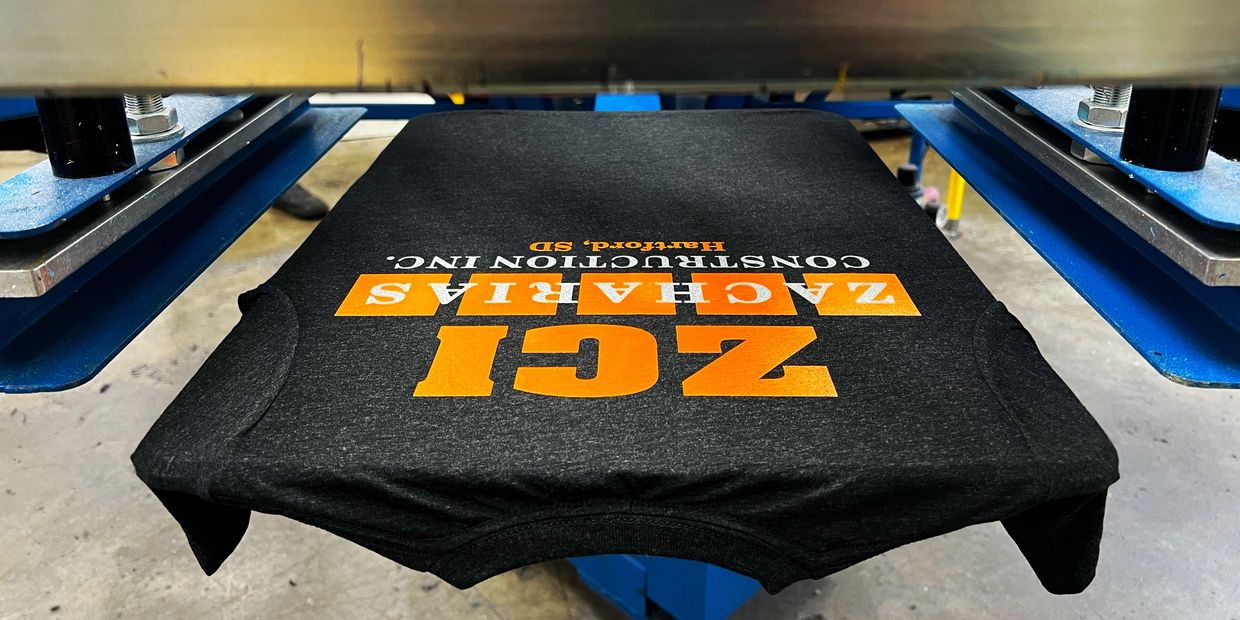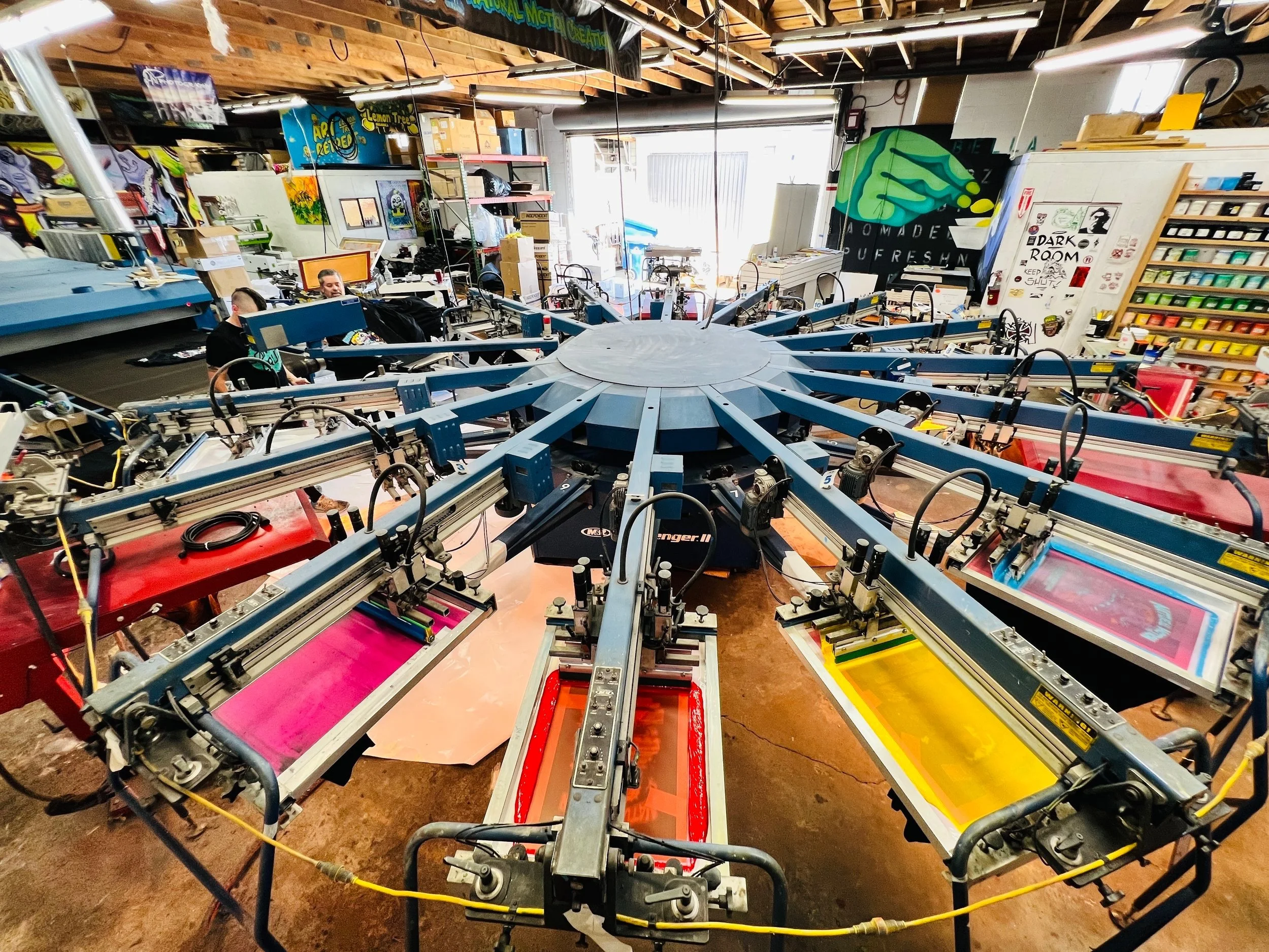Vintage Style Silk Screen Printing for Retro Fashion
Vintage Style Silk Screen Printing for Retro Fashion
Blog Article
Screen Printing Uncovered: Every Little Thing You Need to Learn About T-Shirt and Garment Printing Techniques
If you've ever asked yourself exactly how those vivid layouts wind up on your favorite tee shirts, you remain in the appropriate place. Display printing is a fascinating method that integrates art with technique, using unlimited opportunities for creative thinking. Comprehending the principles, from tools to ink choices, can substantially impact your outcomes. Ready to explore the crucial components that make screen printing an art form? Let's uncover the information that can boost your tasks.
The Essentials of Screen Printing: Just How It Works
When you dive into screen printing, you'll discover it's both a scientific research and an art. At its core, screen printing entails developing a pattern, or display, that allows ink to go through just in particular locations (screen printing kit). You begin by choosing your layout and preparing your display with a light-sensitive solution. As soon as you subject this solution to light, it sets, leaving your layout as an adverse room.
Setting the screen over the material, then make use of a squeegee to press ink through the screen onto the garment. Each action is necessary, and mastering them will certainly raise your display printing abilities, transforming easy garments into unique, meaningful items.
Types of Screen Printing Strategies
Once you grasp the fundamentals of screen printing, it's time to check out the different strategies that can raise your styles. One popular technique is conventional screen printing, where ink is pressed with a stenciled screen. This technique is fantastic for bold, vibrant colors. Then there's water-based ink printing, which supplies a softer feeling and is environment-friendly, but it needs a various method to treating.
Another alternative is plastisol printing, known for its longevity and dazzling colors, making it a preferred for several brands. Experiment with halftone printing to produce gradient impacts and complex designs.
Important Tools for Display Printing
To attain stunning results in display printing, having the right devices is essential. You'll require a durable display printing structure, which holds the mesh that transfers your layout onto the garment. Next off, buy high-quality squeegees; these are essential for applying ink equally throughout the display. You'll also call for a great direct exposure device to create your screens, as well as a washout booth for cleaning them after use. A trustworthy warmth source, like a conveyor dryer or warmth press, is critical for treating your prints to assure long life. Do not fail to remember a proper work area, geared up with tables and storage space for your supplies. Safety equipment, such as masks and gloves, will keep you secure from chemicals and inks. With the right devices, you'll be well on your method to generating professional-quality prints.
Picking the Right Inks and Materials
When selecting inks and materials for display printing, you need to consider the sort of ink that works finest for your job. Consider fabric compatibility to ensure your designs look last and wonderful lengthy. Also, discover environment-friendly ink options to make your printing procedure a lot more lasting.
Kinds of Screen Inks
Selecting the best screen ink is crucial for achieving vibrant, long lasting prints that meet your task's needs. There are several kinds of screen inks to take a look at. Plastisol ink is preferred for its flexibility and ease of usage, giving excellent shade opacity on dark materials. Water-based ink, on the other hand, uses a softer feeling and is eco-friendly, making it excellent for those wanting to reduce their environmental influence. Discharge inks eliminate color from the fabric, resulting in a soft, vintage appearance however require specific handling. Ultimately, specialized inks, such as glow-in-the-dark or metal, can add special effects to your designs. Evaluate your project needs and select the ink that aligns best with your desired outcome.

Material Compatibility Considerations
Comprehending fabric compatibility is important for accomplishing premium display prints, particularly given that various materials react uniquely to various inks. Always examine your inks on sample fabric to assure they adhere correctly and keep color integrity. Additionally, maintain in mind that fabric weight and texture can affect the last result, so choosing the right ink and product combo is crucial for your job's success.
Eco-Friendly Ink Options
Eco-friendly inks are becoming a preferred choice for display printers that intend to decrease their environmental effect while keeping high quality. When selecting inks, think about water-based inks, which are much less hazardous and much easier to tidy up compared to typical solvents. These inks bond well with fabrics, delivering dynamic results without poisonous chemicals. You may likewise check out eco-solvent inks that make use of less volatile organic substances (VOCs), making them a safer option for both your wellness and the planet.
Additionally, try to find inks made from sustainable sources, such as soy or vegetable-based choices. By choosing the best inks and materials, you'll not only develop stunning designs however likewise add to an extra sustainable printing procedure. Make the switch, and your prints will certainly show your dedication to the setting!
Preparing Your Style for Display Printing

File Format Demands
To ensure your design looks sharp and vibrant on fabric, you'll require to pay close focus to file layout needs for screen printing. Make certain your style has a clear history to prevent undesirable white sides on your prints. Keep color settings in mind; CMYK is common for display printing, so transform your RGB designs appropriately.
Color Splitting Up Techniques
Color separation is a crucial step in preparing your style for display printing, and mastering it can greatly boost your print high quality. You'll require to break your design into specific shades, as each shade needs a separate display throughout printing. Start by determining all the colors in your design and produce layers for each one. You can utilize software program like Adobe Photoshop or Illustrator to isolate and different colors efficiently. Be certain to save each layer as a different documents, generally in a style like TIFF or PSD. This accuracy not just ensures accurate shade representation but additionally improves the printing process. By taking note of shade separation, you'll achieve expert and vibrant outcomes in your screen-printed garments.
Resolution and Dimension
Accomplishing the most effective results in display printing begins with ensuring your layout has the appropriate resolution and size. Ideally, your art work needs to be at least 300 DPI (dots per inch) for sharp, clear prints. Your last item could look pixelated and amateur. if you utilize reduced resolution.
When it comes to size, take into consideration the dimensions of your print area. Style your artwork to match the last print size, ideally creating it in the actual dimensions you'll be publishing. In this manner, you'll prevent any type of unforeseen scaling concerns.
Constantly inspect your layout in both vector and raster formats. Vector graphics can be scaled without losing top quality, making them perfect for display printing. Preparing properly will guarantee your layout looks remarkable on every garment!
Step-by-Step Display Printing Refine
Screen printing is a vibrant procedure that enables you to create vibrant styles on different surfaces. To begin, you'll require a display, emulsion, and your chosen ink. Prepare your display by cleaning it thoroughly. Next, apply the solution evenly and allow it dry in a dark location. silk screen printing As soon as dry, expose your display to light with your style put on it, which will certainly solidify the solution where the light hits, producing a pattern - screen printing kit.
After rinsing the unexposed solution, your display is ready. Set it up on your printing surface area and straighten your garment beneath it. Pour ink onto the screen and make use of a squeegee to press the ink via the stencil onto the textile. Raise the display carefully and allow the print dry. Treat the ink using warmth to assure durability. That's it! You've efficiently display printed your layout.
Tips for Effective Screen Printing Projects
While you're diving into your screen printing tasks, keep in mind that preparation is key to success. Start by collecting all your materials-- inks, squeegees, screens, and garments. A tidy office helps protect against undesirable mistakes, so neat up prior to you start.
Following, confirm your art work is high-resolution and correctly sized for your garment. Test your display for correct exposure and clean it thoroughly to stay clear of spots. When blending your inks, comply with the producer's standards to achieve the ideal consistency.
Throughout printing, apply even stress with your squeegee for regular results. Don't rush; take your time to validate each print meets your criteria. After printing, let your garments dry completely before dealing with or packaging them.
Last but not least, constantly keep a sample of your work for future recommendation. In this manner, you can examine your progress and enhance your techniques gradually. Delighted printing!

Often Asked Inquiries
How much time Does It Require To Set up a Screen Printing Work?
Establishing a screen printing task generally takes around thirty minutes to an hour. You'll prepare the displays, mix inks, and adjust the press. The time varies based on intricacy and experience, so stay arranged!
Can I Print on Different Material Enters Making Use Of the Exact Same Method?
Yes, you can publish on various fabric kinds utilizing the exact same method, yet you'll need to change your settings and inks. Some fabrics soak up ink in different ways, so trying out guarantees the very best results for every material.
What Are Common Errors to Stay Clear Of in Screen Printing?
When screen printing, stay clear of common errors like using the wrong ink, neglecting correct direct exposure times, or skipping pre-press checks. Always test your setup and keep tidy screens to ensure top quality outcomes each time.
Exactly How Can I Appropriately Clean and Maintain My Display Printing Devices?
To effectively tidy and maintain your screen printing equipment, you need to routinely clean displays with ideal solvents, check squeegees for wear, and assure all devices are kept dry and dust-free. Uniformity boosts and stops expensive fixings performance.
Is Screen Printing Ecologically Friendly Contrasted to Other Techniques?
Screen printing can be more ecologically pleasant than other approaches, particularly if you utilize eco-conscious materials and water-based inks. By selecting lasting materials and techniques, you lower waste and decrease your effect on the world.
Screen Printing Uncovered: Whatever You Required to Know Concerning T-Shirt and Garment Printing Strategies
At its core, display printing includes creating a stencil, or screen, that permits ink to pass with just in certain areas. Placement the display over the textile, then make use of a squeegee to push ink through the screen onto the garment. One prominent technique is traditional display printing, where ink is pushed via a stenciled screen.When choosing inks and products for screen printing, you require to take into account the type of ink that works finest for your job.
Report this page